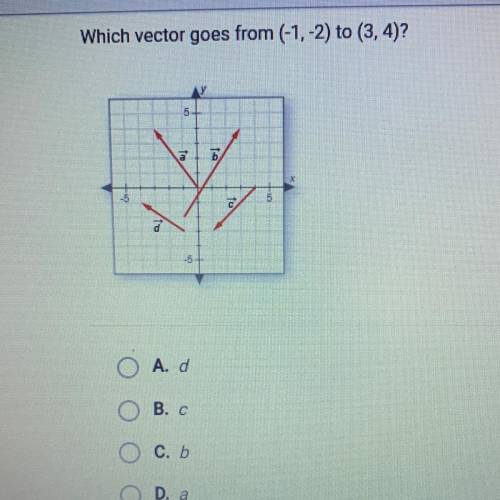Which vector goes from (-1,-2) to (3, 4)?
A. d
B. c
C. b
D. a
...

Answers: 1
Another question on Physics

Physics, 22.06.2019 00:00
How do the measurements of charge at the different locations on the sphere compare to each other? the charge measurements are different at all locations on the sphere. the charge measurements are virtually not the same at all locations on the sphere except for the charge at the very top and at the very bottom that are equal. the charge measurements are virtually the same at all locations on the sphere except for the charge at the very top. at the top, the conductive sphere has a small disk that is made of different material. the charge measurements are the same at all locations on the sphere. what happens to the charge on the conductive sphere when it is connected to a source of charge such as the electrostatic voltage source? nothing will happen because no charge goes around the surface of the sphere. the charge on the conductive sphere spreads out over the surface of the sphere; being greater in some specific locations on the sphere. the charge on the conductive sphere spreads out uniformly over the surface of the sphere. the charge on the conductive sphere spreads out non-uniformly over the surface of the sphere.
Answers: 3

Physics, 22.06.2019 11:30
Which of the following is the phase that results when the moon is on the opposite side of the earth from the sun? a. quarter moon b. crescent moon c. new moon d. full moon
Answers: 1

Physics, 22.06.2019 15:30
To understand the behavior of the electric field at the surface of a conductor, and its relationship to surface charge on the conductor. a conductor is placed in an external electrostatic field. the external field is uniform before the conductor is placed within it. the conductor is completely isolated from any source of current or charge. part a: which of the following describes the electric field inside this conductor? it is in the same direction as the original external field.it is in the opposite direction from that of the original external field.it has a direction determined entirely by the charge on its surface.it is always zero. part b: the charge density inside the conductor is: 0non-zero; but uniformnon-zero; non-uniforminfinite part c: assume that at some point just outside the surface of the conductor, the electric field has magnitude e and is directed toward the surface of the conductor. what is the charge density η on the surface of the conductor at that point? express your answer in terms of e and ϵ0
Answers: 1

You know the right answer?
Questions

English, 22.05.2020 20:59

Mathematics, 22.05.2020 20:59

Mathematics, 22.05.2020 20:59

Mathematics, 22.05.2020 20:59


Chemistry, 22.05.2020 20:59

Biology, 22.05.2020 20:59

History, 22.05.2020 20:59




Mathematics, 22.05.2020 20:59



Social Studies, 22.05.2020 20:59

History, 22.05.2020 20:59

Mathematics, 22.05.2020 20:59

History, 22.05.2020 20:59

Chemistry, 22.05.2020 20:59

History, 22.05.2020 20:59




